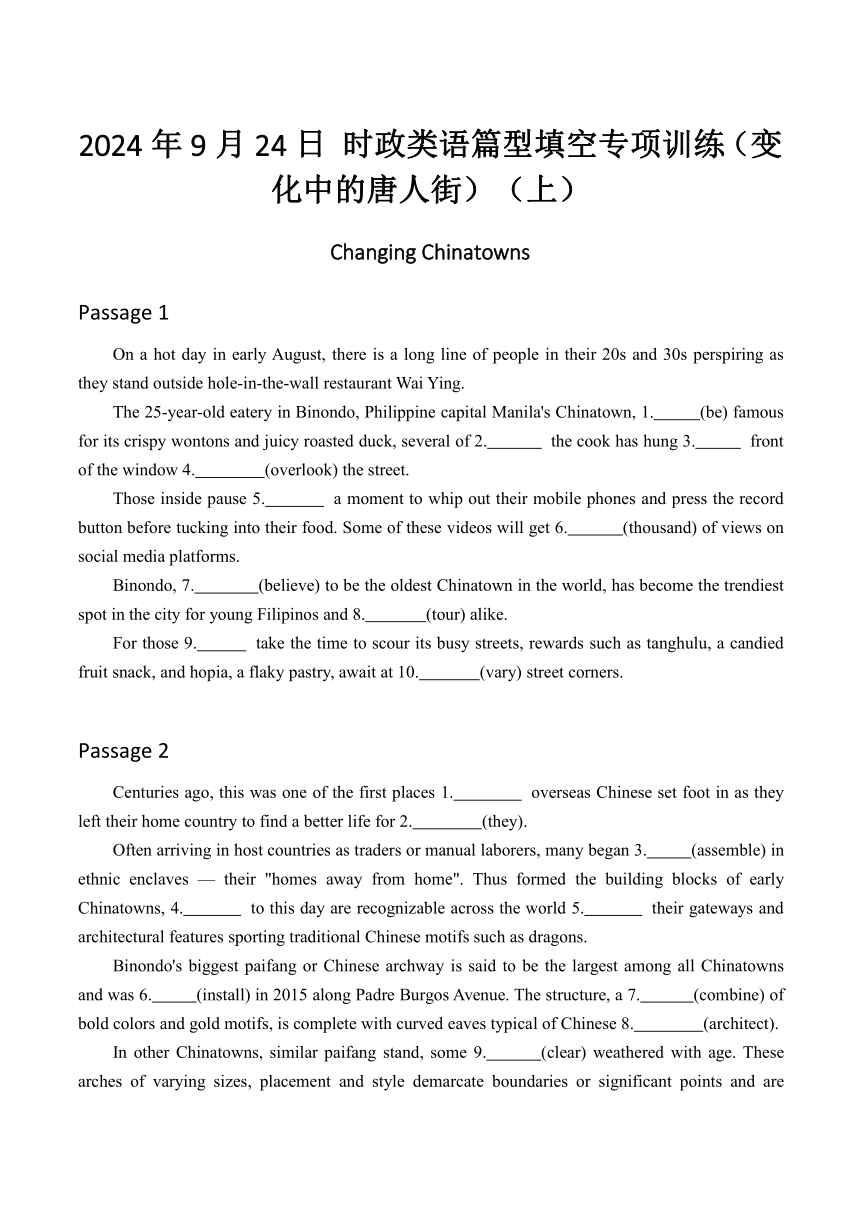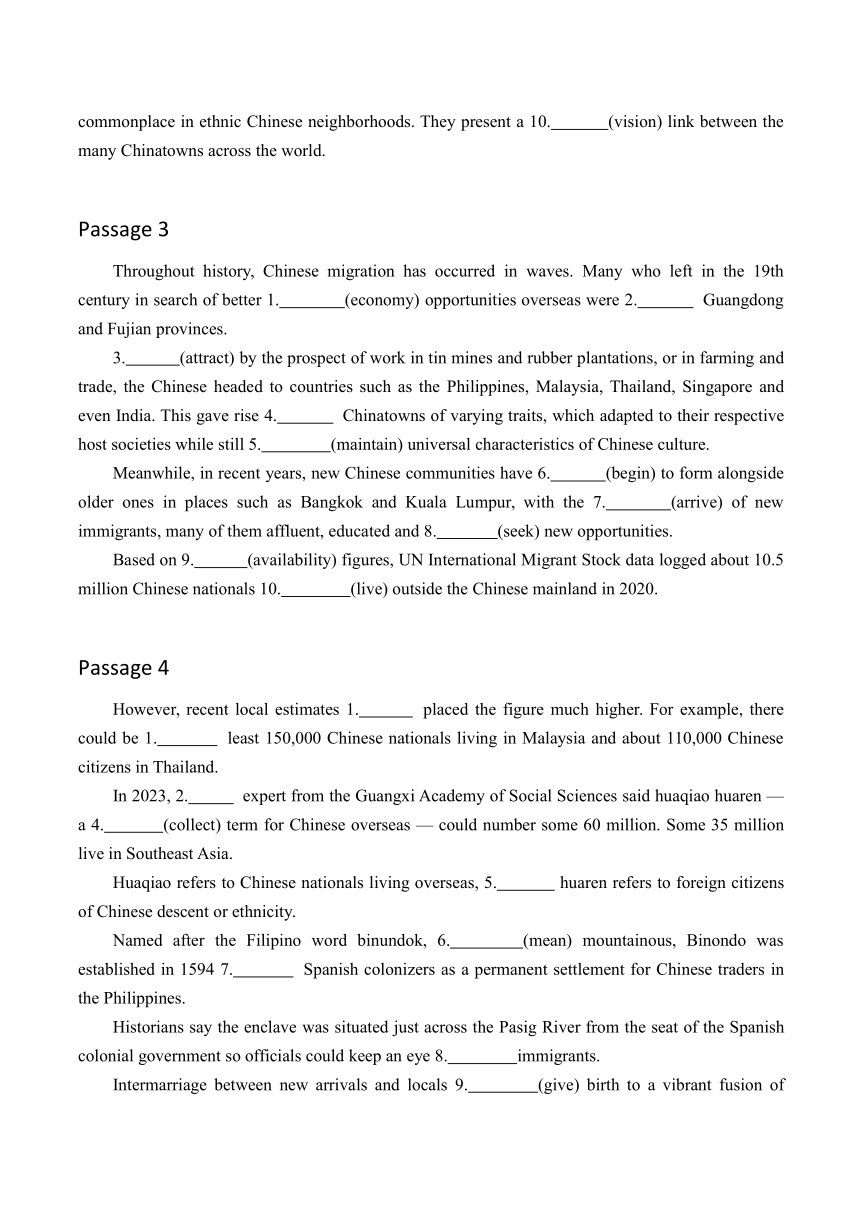2024年9月24日+时政类语篇型填空专项训练(变化中的唐人街)(上)(4篇,含答案与译文)-2025届高三英语二轮复习专项
文档属性
| 名称 | 2024年9月24日+时政类语篇型填空专项训练(变化中的唐人街)(上)(4篇,含答案与译文)-2025届高三英语二轮复习专项 |  | |
| 格式 | docx | ||
| 文件大小 | 28.9KB | ||
| 资源类型 | 教案 | ||
| 版本资源 | 人教版(2019) | ||
| 科目 | 英语 | ||
| 更新时间 | 2025-01-15 13:52:08 | ||
图片预览


文档简介
2024年9月24日 时政类语篇型填空专项训练(变化中的唐人街)(上)
Changing Chinatowns
Passage 1
On a hot day in early August, there is a long line of people in their 20s and 30s perspiring as they stand outside hole-in-the-wall restaurant Wai Ying.
The 25-year-old eatery in Binondo, Philippine capital Manila's Chinatown, 1. (be) famous for its crispy wontons and juicy roasted duck, several of 2. the cook has hung 3. front of the window 4. (overlook) the street.
Those inside pause 5. a moment to whip out their mobile phones and press the record button before tucking into their food. Some of these videos will get 6. (thousand) of views on social media platforms.
Binondo, 7. (believe) to be the oldest Chinatown in the world, has become the trendiest spot in the city for young Filipinos and 8. (tour) alike.
For those 9. take the time to scour its busy streets, rewards such as tanghulu, a candied fruit snack, and hopia, a flaky pastry, await at 10. (vary) street corners.
Passage 2
Centuries ago, this was one of the first places 1. overseas Chinese set foot in as they left their home country to find a better life for 2. (they).
Often arriving in host countries as traders or manual laborers, many began 3. (assemble) in ethnic enclaves — their "homes away from home". Thus formed the building blocks of early Chinatowns, 4. to this day are recognizable across the world 5. their gateways and architectural features sporting traditional Chinese motifs such as dragons.
Binondo's biggest paifang or Chinese archway is said to be the largest among all Chinatowns and was 6. (install) in 2015 along Padre Burgos Avenue. The structure, a 7. (combine) of bold colors and gold motifs, is complete with curved eaves typical of Chinese 8. (architect).
In other Chinatowns, similar paifang stand, some 9. (clear) weathered with age. These arches of varying sizes, placement and style demarcate boundaries or significant points and are commonplace in ethnic Chinese neighborhoods. They present a 10. (vision) link between the many Chinatowns across the world.
Passage 3
Throughout history, Chinese migration has occurred in waves. Many who left in the 19th century in search of better 1. (economy) opportunities overseas were 2. Guangdong and Fujian provinces.
3. (attract) by the prospect of work in tin mines and rubber plantations, or in farming and trade, the Chinese headed to countries such as the Philippines, Malaysia, Thailand, Singapore and even India. This gave rise 4. Chinatowns of varying traits, which adapted to their respective host societies while still 5. (maintain) universal characteristics of Chinese culture.
Meanwhile, in recent years, new Chinese communities have 6. (begin) to form alongside older ones in places such as Bangkok and Kuala Lumpur, with the 7. (arrive) of new immigrants, many of them affluent, educated and 8. (seek) new opportunities.
Based on 9. (availability) figures, UN International Migrant Stock data logged about 10.5 million Chinese nationals 10. (live) outside the Chinese mainland in 2020.
Passage 4
However, recent local estimates 1. placed the figure much higher. For example, there could be 1. least 150,000 Chinese nationals living in Malaysia and about 110,000 Chinese citizens in Thailand.
In 2023, 2. expert from the Guangxi Academy of Social Sciences said huaqiao huaren — a 4. (collect) term for Chinese overseas — could number some 60 million. Some 35 million live in Southeast Asia.
Huaqiao refers to Chinese nationals living overseas, 5. huaren refers to foreign citizens of Chinese descent or ethnicity.
Named after the Filipino word binundok, 6. (mean) mountainous, Binondo was established in 1594 7. Spanish colonizers as a permanent settlement for Chinese traders in the Philippines.
Historians say the enclave was situated just across the Pasig River from the seat of the Spanish colonial government so officials could keep an eye 8. immigrants.
Intermarriage between new arrivals and locals 9. (give) birth to a vibrant fusion of Chinese and Filipino cultures 10. has defined aspects of life in Manila's Chinatown. The area is home to some 20,000 people today.
参考答案
参考答案1
1.is 2.which 3.in 4.overlooking 5.for
6.thousands 7.believed 8.tourists 9.who 10.various
参考译文1
八月初的某个炎热的日子,在一家简陋的餐馆 Wai Ying 外面,排着长队,一群二三十岁的人汗流浃背。
这家拥有 25 年历史的餐馆位于菲律宾首都马尼拉唐人街比农洛,以其酥脆的馄饨和多汁的烤鸭而闻名,厨师将其中几样挂在俯瞰街道的窗户前。
里面的人会停下来,拿出手机按下录制按钮,然后开始享用美食。其中一些视频在社交媒体平台上的点击量达到数千次。
岷伦洛被认为是世界上最古老的唐人街,对于菲律宾年轻人和游客来说,它已经成为这座城市最时尚的地点。
对于那些花时间搜寻繁忙街道的人来说,在各个街角等待着他们的是诸如糖葫芦(一种蜜饯小吃)和霍皮亚(一种酥皮糕点)之类的奖励。
参考答案2
1.that 2.themselves 3.assembling 4.which 5.by
6.installed 7.combination 8.architecture 9.clearly 10.visual
参考译文2
几个世纪前,这里是海外华人离开祖国,寻求更好生活最先踏足的地方之一。
很多移民以商人或体力劳动者的身份来到东道国,他们开始聚集在少数民族聚居地——他们的“家外之家”。早期的唐人街由此形成,至今,唐人街仍以其门道和带有龙等中国传统图案的建筑特色而闻名于世。
岷伦洛最大的牌坊,即中式拱门,据说是所有唐人街中最大的,于 2015 年在 Padre Burgos 大道建成。该建筑采用大胆的色彩和金色图案,并配有典型的中式建筑弧形屋檐。
在其他唐人街也有类似的牌坊,其中一些明显已因岁月的侵蚀而风化。这些大小、位置和风格各异的牌坊划定了边界或重要地点,在华人社区中很常见。它们为世界各地的许多唐人街提供了视觉联系。
参考答案3
1.economic 2.from 3.Attracted 4.to 5.maintaining
6.begun 7.arrival 8.seeking 9.available 10.living
参考译文3
纵观历史,华人移民潮一波接一波。19 世纪离开中国到海外寻找更好经济机会的华人大多来自广东和福建。
受锡矿、橡胶种植园、农业和贸易等工作前景的吸引,华人纷纷前往菲律宾、马来西亚、泰国、新加坡甚至印度等国家。这催生了各种特色的唐人街,这些唐人街既适应了各自的东道社会,又保留了中国文化的普遍特征。
与此同时,近年来,随着新移民的到来,曼谷和吉隆坡等地的华人社区与传统的华人社区一起开始形成新的华人社区,其中许多新移民富裕、受过教育且寻求新的机会。
根据现有数据,联合国国际移民存量数据显示,2020年居住在中国大陆以外的中国公民约有1050万人。
参考答案4
1.have 2.at 3.an 4.collective 5.while
6.meaning 7.by 8.on 9.gave 10.that
参考译文4
然而,最近当地的估计数字要高得多。例如,马来西亚可能有至少15万名中国公民,泰国可能有约11万名中国公民。
广西社会科学院的一位专家表示,到2023年,华侨华人的数量可能会达到6000万左右。其中约有3500万人生活在东南亚。
“华侨”指居住在海外的中国公民,“华人”指具有华裔或华族的外国公民。
岷伦洛镇以菲律宾语binundok (意为山)命名,由西班牙殖民者于 1594 年建立,作为菲律宾中国商人的永久定居点。
历史学家说,这片飞地位于西班牙殖民政府所在地帕西格河对岸,以便官员能够监视移民。
新移民与当地人通婚催生了中国和菲律宾文化的融合,这种融合定义了马尼拉唐人街的生活。如今,该地区约有 20,000 人居住。
Changing Chinatowns
Passage 1
On a hot day in early August, there is a long line of people in their 20s and 30s perspiring as they stand outside hole-in-the-wall restaurant Wai Ying.
The 25-year-old eatery in Binondo, Philippine capital Manila's Chinatown, 1. (be) famous for its crispy wontons and juicy roasted duck, several of 2. the cook has hung 3. front of the window 4. (overlook) the street.
Those inside pause 5. a moment to whip out their mobile phones and press the record button before tucking into their food. Some of these videos will get 6. (thousand) of views on social media platforms.
Binondo, 7. (believe) to be the oldest Chinatown in the world, has become the trendiest spot in the city for young Filipinos and 8. (tour) alike.
For those 9. take the time to scour its busy streets, rewards such as tanghulu, a candied fruit snack, and hopia, a flaky pastry, await at 10. (vary) street corners.
Passage 2
Centuries ago, this was one of the first places 1. overseas Chinese set foot in as they left their home country to find a better life for 2. (they).
Often arriving in host countries as traders or manual laborers, many began 3. (assemble) in ethnic enclaves — their "homes away from home". Thus formed the building blocks of early Chinatowns, 4. to this day are recognizable across the world 5. their gateways and architectural features sporting traditional Chinese motifs such as dragons.
Binondo's biggest paifang or Chinese archway is said to be the largest among all Chinatowns and was 6. (install) in 2015 along Padre Burgos Avenue. The structure, a 7. (combine) of bold colors and gold motifs, is complete with curved eaves typical of Chinese 8. (architect).
In other Chinatowns, similar paifang stand, some 9. (clear) weathered with age. These arches of varying sizes, placement and style demarcate boundaries or significant points and are commonplace in ethnic Chinese neighborhoods. They present a 10. (vision) link between the many Chinatowns across the world.
Passage 3
Throughout history, Chinese migration has occurred in waves. Many who left in the 19th century in search of better 1. (economy) opportunities overseas were 2. Guangdong and Fujian provinces.
3. (attract) by the prospect of work in tin mines and rubber plantations, or in farming and trade, the Chinese headed to countries such as the Philippines, Malaysia, Thailand, Singapore and even India. This gave rise 4. Chinatowns of varying traits, which adapted to their respective host societies while still 5. (maintain) universal characteristics of Chinese culture.
Meanwhile, in recent years, new Chinese communities have 6. (begin) to form alongside older ones in places such as Bangkok and Kuala Lumpur, with the 7. (arrive) of new immigrants, many of them affluent, educated and 8. (seek) new opportunities.
Based on 9. (availability) figures, UN International Migrant Stock data logged about 10.5 million Chinese nationals 10. (live) outside the Chinese mainland in 2020.
Passage 4
However, recent local estimates 1. placed the figure much higher. For example, there could be 1. least 150,000 Chinese nationals living in Malaysia and about 110,000 Chinese citizens in Thailand.
In 2023, 2. expert from the Guangxi Academy of Social Sciences said huaqiao huaren — a 4. (collect) term for Chinese overseas — could number some 60 million. Some 35 million live in Southeast Asia.
Huaqiao refers to Chinese nationals living overseas, 5. huaren refers to foreign citizens of Chinese descent or ethnicity.
Named after the Filipino word binundok, 6. (mean) mountainous, Binondo was established in 1594 7. Spanish colonizers as a permanent settlement for Chinese traders in the Philippines.
Historians say the enclave was situated just across the Pasig River from the seat of the Spanish colonial government so officials could keep an eye 8. immigrants.
Intermarriage between new arrivals and locals 9. (give) birth to a vibrant fusion of Chinese and Filipino cultures 10. has defined aspects of life in Manila's Chinatown. The area is home to some 20,000 people today.
参考答案
参考答案1
1.is 2.which 3.in 4.overlooking 5.for
6.thousands 7.believed 8.tourists 9.who 10.various
参考译文1
八月初的某个炎热的日子,在一家简陋的餐馆 Wai Ying 外面,排着长队,一群二三十岁的人汗流浃背。
这家拥有 25 年历史的餐馆位于菲律宾首都马尼拉唐人街比农洛,以其酥脆的馄饨和多汁的烤鸭而闻名,厨师将其中几样挂在俯瞰街道的窗户前。
里面的人会停下来,拿出手机按下录制按钮,然后开始享用美食。其中一些视频在社交媒体平台上的点击量达到数千次。
岷伦洛被认为是世界上最古老的唐人街,对于菲律宾年轻人和游客来说,它已经成为这座城市最时尚的地点。
对于那些花时间搜寻繁忙街道的人来说,在各个街角等待着他们的是诸如糖葫芦(一种蜜饯小吃)和霍皮亚(一种酥皮糕点)之类的奖励。
参考答案2
1.that 2.themselves 3.assembling 4.which 5.by
6.installed 7.combination 8.architecture 9.clearly 10.visual
参考译文2
几个世纪前,这里是海外华人离开祖国,寻求更好生活最先踏足的地方之一。
很多移民以商人或体力劳动者的身份来到东道国,他们开始聚集在少数民族聚居地——他们的“家外之家”。早期的唐人街由此形成,至今,唐人街仍以其门道和带有龙等中国传统图案的建筑特色而闻名于世。
岷伦洛最大的牌坊,即中式拱门,据说是所有唐人街中最大的,于 2015 年在 Padre Burgos 大道建成。该建筑采用大胆的色彩和金色图案,并配有典型的中式建筑弧形屋檐。
在其他唐人街也有类似的牌坊,其中一些明显已因岁月的侵蚀而风化。这些大小、位置和风格各异的牌坊划定了边界或重要地点,在华人社区中很常见。它们为世界各地的许多唐人街提供了视觉联系。
参考答案3
1.economic 2.from 3.Attracted 4.to 5.maintaining
6.begun 7.arrival 8.seeking 9.available 10.living
参考译文3
纵观历史,华人移民潮一波接一波。19 世纪离开中国到海外寻找更好经济机会的华人大多来自广东和福建。
受锡矿、橡胶种植园、农业和贸易等工作前景的吸引,华人纷纷前往菲律宾、马来西亚、泰国、新加坡甚至印度等国家。这催生了各种特色的唐人街,这些唐人街既适应了各自的东道社会,又保留了中国文化的普遍特征。
与此同时,近年来,随着新移民的到来,曼谷和吉隆坡等地的华人社区与传统的华人社区一起开始形成新的华人社区,其中许多新移民富裕、受过教育且寻求新的机会。
根据现有数据,联合国国际移民存量数据显示,2020年居住在中国大陆以外的中国公民约有1050万人。
参考答案4
1.have 2.at 3.an 4.collective 5.while
6.meaning 7.by 8.on 9.gave 10.that
参考译文4
然而,最近当地的估计数字要高得多。例如,马来西亚可能有至少15万名中国公民,泰国可能有约11万名中国公民。
广西社会科学院的一位专家表示,到2023年,华侨华人的数量可能会达到6000万左右。其中约有3500万人生活在东南亚。
“华侨”指居住在海外的中国公民,“华人”指具有华裔或华族的外国公民。
岷伦洛镇以菲律宾语binundok (意为山)命名,由西班牙殖民者于 1594 年建立,作为菲律宾中国商人的永久定居点。
历史学家说,这片飞地位于西班牙殖民政府所在地帕西格河对岸,以便官员能够监视移民。
新移民与当地人通婚催生了中国和菲律宾文化的融合,这种融合定义了马尼拉唐人街的生活。如今,该地区约有 20,000 人居住。
